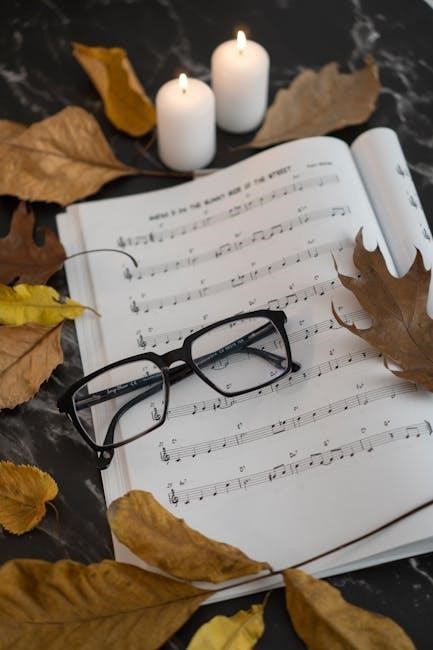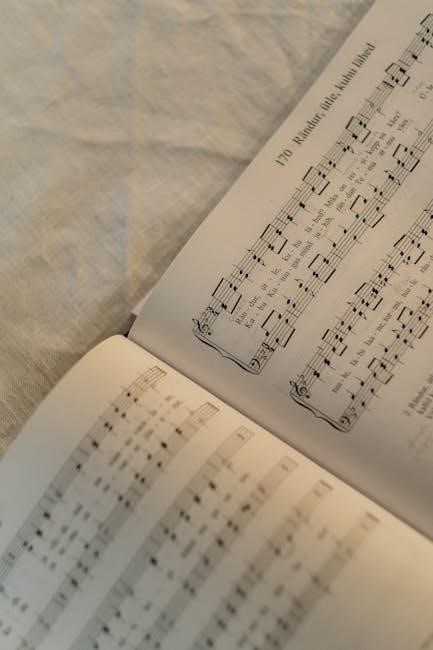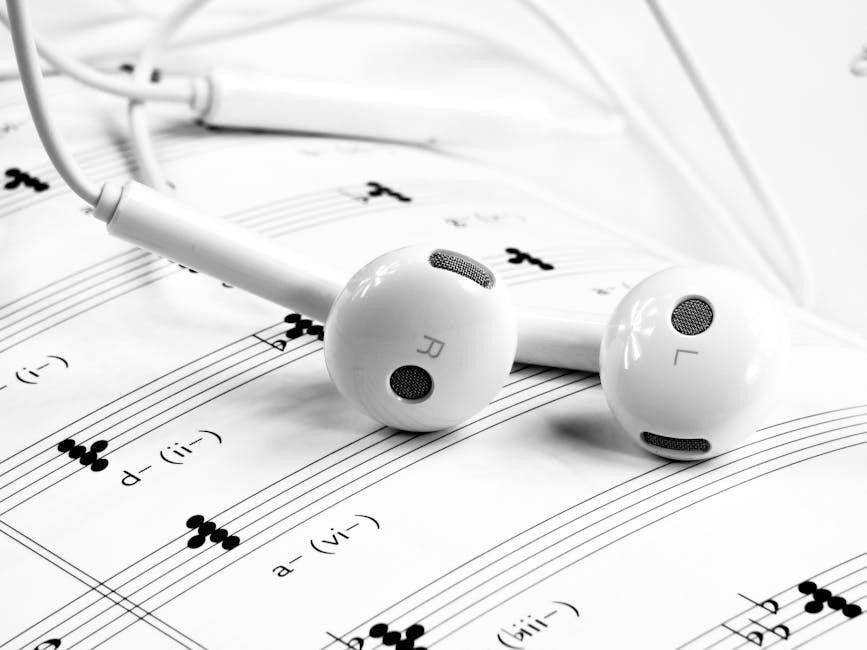Edelweiss, a timeless song from The Sound of Music, symbolizes hope and resilience. Created by Rodgers and Hammerstein, it became an Austrian anthem, celebrating beauty and freedom.
Background of the Song “Edelweiss”
Written by Richard Rodgers and Oscar Hammerstein II, “Edelweiss” was introduced in the 1965 film The Sound of Music. Sung by Captain Georg von Trapp, the song symbolizes hope and resilience. Its gentle melody and heartfelt lyrics pay tribute to Austria’s beauty and freedom. The song’s title refers to the rare alpine flower, edelweiss, which is deeply rooted in Austrian culture. It has since become an iconic anthem, celebrating nature and national pride.
The Role of “Edelweiss” in The Sound of Music
In The Sound of Music, “Edelweiss” serves as a poignant expression of Austrian patriotism and defiance against Nazi occupation. Sung by Captain Georg von Trapp, the song becomes a powerful symbol of resistance and love for one’s homeland. Its gentle melody and heartfelt lyrics resonate deeply, making it a memorable moment in the film. The song’s emotional depth and cultural significance have cemented its place as a beloved classic in musical history.
Cultural Impact and Popularity of the Song
“Edelweiss” has become an iconic anthem, symbolizing Austrian national pride and resilience. Its gentle melody and heartfelt lyrics resonate globally, transcending cultural boundaries. Featured prominently in The Sound of Music, the song gained worldwide acclaim, making it a beloved classic. Its popularity endures, with sheet music in high demand for various instruments, reflecting its timeless appeal and emotional connection with audiences of all ages.

Sheet Music Availability and Formats
Edelweiss sheet music is widely available in PDF and print formats, suitable for various skill levels. It can be downloaded from online repositories or purchased from music stores.
Sources for “Edelweiss” Sheet Music PDF
Reputable sources for Edelweiss sheet music PDF include Musicnotes, SheetMusicPlus, and MuseScore. These platforms offer high-quality arrangements for various instruments and vocal ranges. Additionally, websites like IMSLP provide free public domain scores, while Amazon and Google Play offer digital downloads. Ensure legality by purchasing from licensed sellers or using free resources responsibly, respecting copyright laws.
Different Arrangements and Versions
Edelweiss is available in various arrangements, catering to diverse musical preferences. Piano, vocal, and instrumental versions are popular, with adaptations for guitar, violin, and choir. The song also exists in multiple languages, including German and English, broadening its appeal. Additionally, simplified versions for beginners and complex arrangements for advanced musicians are accessible, ensuring the melody resonates with everyone. These variations highlight the timeless adaptability of Edelweiss, making it a universal favorite.
Free vs. Paid Sheet Music Options
Free sheet music for “Edelweiss” is available online, often through educational or non-commercial platforms, but may lack professional arrangements; Paid versions offer high-quality, licensed PDFs with detailed notation, suitable for performers. Websites like Musicnotes or Sheet Music Plus provide authentic scores, ensuring legality and accuracy. Free options are ideal for casual use, while paid versions are better for professional performances or intricate arrangements, balancing cost and quality based on user needs.

Composers and Their Contribution
Richard Rodgers and Oscar Hammerstein II created “Edelweiss,” blending emotional depth with memorable melodies. Their collaboration for The Sound of Music left a timeless musical legacy.
Richard Rodgers and Oscar Hammerstein II
Richard Rodgers and Oscar Hammerstein II were legendary composers and lyricists, renowned for their iconic collaborations. They created Edelweiss for The Sound of Music, blending heartfelt lyrics with a soothing melody. Their work captured the essence of Austrian culture, making the song a timeless classic. Rodgers’ musical genius and Hammerstein’s poetic lyrics ensured Edelweiss became a beloved piece, cherished in sheet music collections worldwide.
Their Collaboration on The Sound of Music
Richard Rodgers and Oscar Hammerstein II’s collaboration on The Sound of Music produced timeless classics, including “Edelweiss.” This song, written for Captain von Trapp, blends emotional depth with a soaring melody, reflecting their mastery of storytelling through music. Its creation marked a pivotal moment in the musical, symbolizing hope and resilience; The duo’s partnership not only elevated the film but also cemented “Edelweiss” as a cultural icon, cherished for its beauty and historical significance.
Legacy of Rodgers and Hammerstein
Rodgers and Hammerstein are legendary for their enduring contributions to musical theater; Their collaboration on The Sound of Music cemented their legacy, with “Edelweiss” becoming an iconic piece. Their ability to blend emotional depth with memorable melodies has influenced generations of composers. The duo’s work continues to resonate globally, shaping both Broadway and popular culture. Their innovative storytelling and musical genius remain unparalleled, ensuring their creations, like “Edelweiss,” stay timeless and cherished.
Lyrics and Musical Composition
English Lyrics of “Edelweiss”
Edelweiss, edelweiss, every morning you greet me, small and white, clean and bright. A symbol of hope, its lyrics evoke simplicity and beauty, crafted by Rodgers and Hammerstein.
The English lyrics of “Edelweiss” are poetic and heartfelt, describing the flower’s beauty and symbolism. They begin, “Edelweiss, Edelweiss, Every morning you greet me, Small and white, clean and bright, You look happy to meet me.” The lyrics, written by Oscar Hammerstein II, capture the flower’s delicate charm and its significance as a symbol of hope and resilience, making the song a beloved classic in both musical and cultural contexts.
German and Other Language Versions
The song “Edelweiss” was originally written in English but has been translated into multiple languages, including German and Chinese. The German version, Edelweiß, features slight lyrical variations while maintaining its emotional depth. Other language adaptations ensure the song’s universal appeal, preserving its cultural significance. These translations highlight the melody’s adaptability and enduring popularity across global audiences.
Musical Structure and Melody

The melody of “Edelweiss” is gentle and soothing, with a simple yet elegant structure. Composed in C Major, it features a moderate tempo, making it accessible for various arrangements. The song’s harmony and rhythm evoke a sense of calm, aligning with its themes of beauty and resilience. Its melodic simplicity allows for versatile interpretations, from piano solos to orchestral renditions, ensuring its enduring appeal across generations and musical styles.
Sheet Music for Different Instruments

Edelweiss sheet music is available for piano, guitar, violin, and vocal arrangements, offering versatile options for musicians of all skill levels in PDF and digital formats.
Piano Sheet Music for “Edelweiss”
The piano sheet music for “Edelweiss” captures the song’s delicate melody and emotional depth. Available in PDF format, it suits pianists of all skill levels, from beginners to advanced players. The arrangement highlights the song’s gentle, flowing rhythm, making it a popular choice for recitals and personal enjoyment. Many versions include chord charts and dynamics to enhance performance. Whether played as a solo or accompaniment, the piano sheet music brings the timeless beauty of “Edelweiss” to life.
Vocal Sheet Music and Chord Charts
Vocal sheet music for “Edelweiss” is widely available, offering chord charts for various vocal ranges. These arrangements cater to both solo and choral performances, ensuring accessibility for singers of all levels. Many versions include piano accompaniment, while others feature guitar chords for acoustic renditions. Digital downloads often provide interactive tools, allowing singers to adjust keys and tempos. Whether for personal practice or professional performances, these resources make “Edelweiss” a timeless choice for vocalists worldwide.
Instrumental Arrangements (Guitar, Violin, etc.)
Instrumental arrangements of “Edelweiss” are popular for guitar, violin, and other instruments. The melody’s simplicity makes it accessible for various adaptations. Guitar arrangements often use fingerpicking for a soft sound, while violin versions highlight the song’s lyrical quality. Sheet music for these instruments is widely available, catering to both beginners and advanced players. This versatility ensures “Edelweiss” remains a beloved piece across different musical genres and skill levels.

Legal and Copyright Considerations
Using “Edelweiss” sheet music requires adherence to copyright laws. Licensing is mandatory for public performances, while fair use applies to educational or non-commercial purposes only.
Copyright Laws and Sheet Music Usage
Using “Edelweiss” sheet music requires adherence to copyright laws, as the song is protected by Rodgers and Hammerstein’s estate. Permission is needed for public performances or commercial use. Purchasing from authorized sellers ensures legality. Licensing is mandatory for public displays, while fair use applies only to educational or non-commercial contexts. Respect copyright to avoid legal issues and support the creators’ legacy.
Licensing for Public Performance
Public performances of “Edelweiss” require proper licensing to comply with copyright laws. Obtaining a license ensures legal use of the song in concerts, theaters, or other public events. Platforms like Musicnotes or Sheet Music Plus often provide licensing options along with sheet music downloads. Failure to secure a license may result in legal consequences. Always verify the terms of use for public performances to respect the rights of composers and publishers.
Fair Use and Educational Exceptions
Fair use provisions allow limited use of copyrighted material like “Edelweiss” sheet music for education, commentary, or research. Educational institutions often benefit from exceptions, enabling teachers and students to use the music in classroom settings without infringement. These exceptions promote learning and cultural appreciation while respecting copyright laws. Proper attribution and non-commercial use are key to complying with fair use and educational exceptions, ensuring access to “Edelweiss” for educational purposes.
Tips for Playing “Edelweiss”
Start with a slow tempo to master the melody, focus on clear articulation, and emphasize emotional expression to convey the song’s gentle and hopeful essence.
Beginner-Friendly Tips for Piano Players

Start with a slow tempo to master the waltz rhythm. Focus on the melody in the right hand, keeping it simple and clear. Use dynamics, playing softly for a gentle feel. Practice chord progressions in the left hand separately before combining. Begin with the verse, then gradually add the chorus. Use sheet music with clear markings for finger placement. Break the piece into sections for easier learning. Add ornaments like trills sparingly for character. Use a metronome to maintain timing.
Vocal Techniques for Singing “Edelweiss”

To master “Edelweiss,” focus on breath control for its flowing melody. Emphasize clear diction, especially in the German version, and maintain soft dynamics. Practice phrasing to convey the song’s emotional depth, ensuring a smooth transition between verses and chorus. Pay attention to pitch accuracy and subtle vibrato to enhance the lyrical quality. Warm up with gentle exercises to prepare your voice for the moderate range and sustained notes. Connect with the lyrics’ themes of hope and resilience for an authentic performance.
Advanced Arrangement Ideas
For advanced musicians, “Edelweiss” can be reimagined with intricate harmonies and layered instrumentation. Consider adding a string section or jazz ensemble for depth. Experiment with modal interchange or unexpected key changes to create a modern twist. A piano concerto version could highlight the melody’s elegance, while a vocal a cappella arrangement might emphasize its emotional resonance. Incorporating minor keys or unconventional time signatures can add complexity, making it a standout piece for skilled performers.
Historical Context of the Song
Edelweiss, inspired by Austria’s national flower, reflects themes of hope and resilience. Written by Rodgers and Hammerstein for The Sound of Music, it symbolizes freedom and national identity.
Inspiration Behind “Edelweiss”
The song “Edelweiss” was inspired by the delicate Alpine flower, symbolizing purity and resilience. Rodgers and Hammerstein crafted it for The Sound of Music, blending Austrian culture with universal themes of hope and identity. The lyrics reflect a deep appreciation for nature and heritage, making it a beloved anthem that transcends its cinematic origins.
The Song’s Role in Austrian Culture
Edelweiss has become an anthem of Austrian identity, symbolizing national pride and resilience. Its gentle melody and heartfelt lyrics resonate deeply, often performed at cultural events and celebrations. The song’s adoption as an unofficial Austrian anthem reflects its emotional connection to the people, celebrating the beauty of the Alps and the enduring spirit of the nation. It remains a cherished symbol of Austrian heritage, bridging generations through its timeless appeal and cultural significance.
Historical Significance in The Sound of Music
In The Sound of Music, “Edelweiss” symbolizes Austrian patriotism and resistance against Nazi annexation. Sung by Captain von Trapp, it becomes a powerful anthem of defiance and love for his homeland. The song’s gentle melody contrasts with its profound message, reflecting the turmoil of the era. Its performance at the Salzburg Music Festival marks a pivotal moment, showcasing the family’s courage and commitment to their heritage. This scene underscores the song’s enduring historical and emotional resonance.
Where to Download or Purchase
Reputable platforms like Musicnotes and Sheet Music Plus offer “Edelweiss” sheet music PDFs. Digital downloads are convenient, while physical copies are available at music stores.
Reputable Websites for Sheet Music PDFs
Reputable websites like Musicnotes, SheetMusicPlus, and MuseScore offer high-quality “Edelweiss” sheet music PDFs. These platforms provide accurate transcriptions for various instruments and vocal arrangements. They ensure legality and quality, making them trusted sources for musicians. Always choose licensed providers to support creators and avoid copyright issues.
Platforms Offering Digital Downloads
Popular platforms like Musicnotes, Sheet Music Plus, and MuseScore offer high-quality “Edelweiss” sheet music PDFs. These sites provide instant downloads, multiple instrument arrangements, and user-friendly interfaces. They cater to both professionals and hobbyists, ensuring accessibility and convenience for musicians worldwide.
Physical Copies and Sheet Music Stores
Physical copies of “Edelweiss” sheet music are available at music stores and retailers specializing in classical or Broadway scores. Stores like Musicnotes, Sheet Music Plus, and local music shops offer high-quality prints. These stores often provide a variety of arrangements, catering to pianists, vocalists, and instrumentalists. Purchasing physical copies ensures a tangible, durable product, ideal for performances and practice. Many musicians prefer physical sheet music for its nostalgic appeal and ease of use during rehearsals or live events.

The Future of Sheet Music Distribution
Digital sheet music distribution is revolutionizing access, offering eco-friendly solutions and global reach, ensuring timeless classics like “Edelweiss” remain accessible to future generations through innovative platforms.
Digital Sheet Music and Its Advantages
Digital sheet music for “Edelweiss” offers unparalleled convenience and accessibility. It allows instant downloads, eliminating the need for physical storage. Musicians can access it on various devices, making practice and performance seamless. Digital formats also reduce environmental impact by minimizing paper use. Additionally, digital sheet music often includes interactive features like adjustable tempos and transposition, enhancing learning and performance. This modern approach ensures that “Edelweiss” remains accessible to future generations while supporting sustainable music distribution practices.
Impact of Technology on Music Distribution
Technology has revolutionized how sheet music, like “Edelweiss,” is distributed. Digital platforms now offer instant access to PDFs, reducing reliance on physical copies. This shift has made music more accessible globally, especially for rare or classic pieces. Digital downloads also lower costs and environmental impact, promoting sustainability. The rise of online marketplaces has further democratized music distribution, ensuring that “Edelweiss” and similar works remain widely available and easily attainable for musicians and enthusiasts worldwide.
Sustainability in Sheet Music Production
The shift to digital sheet music, like Edelweiss PDFs, reduces environmental impact by minimizing paper use. Digital formats lower production costs and carbon footprints, promoting eco-friendly music distribution. This trend supports sustainable practices, ensuring music remains accessible while preserving natural resources for future generations.
